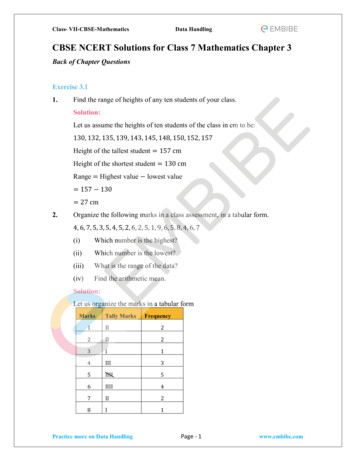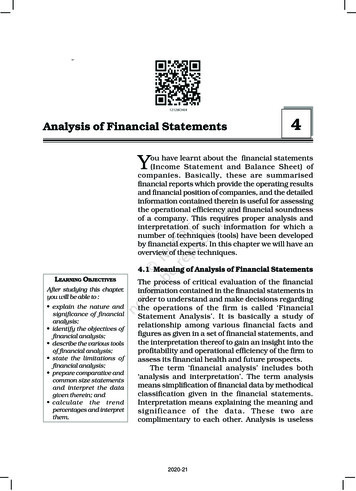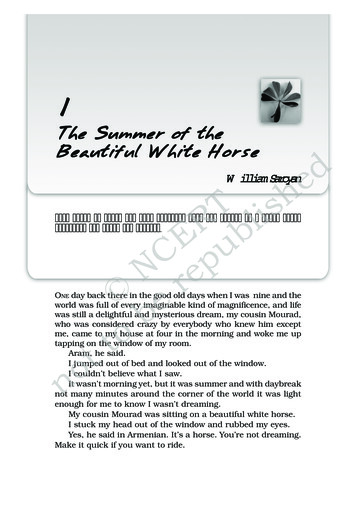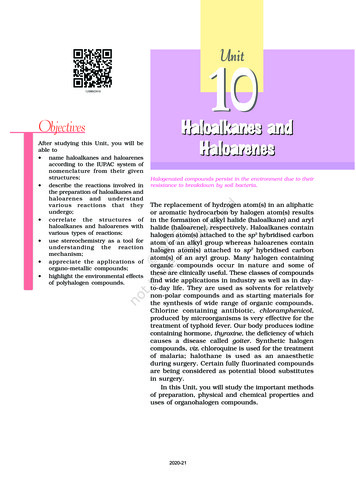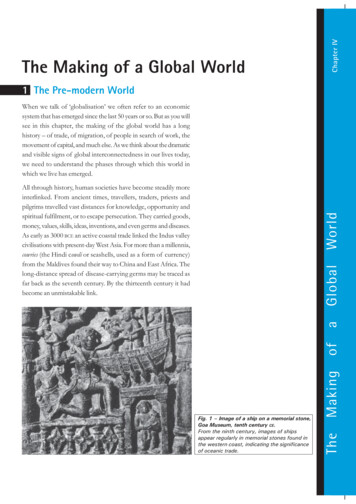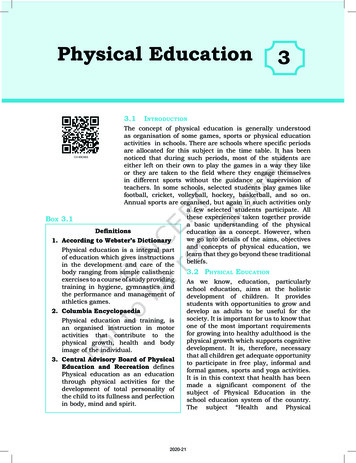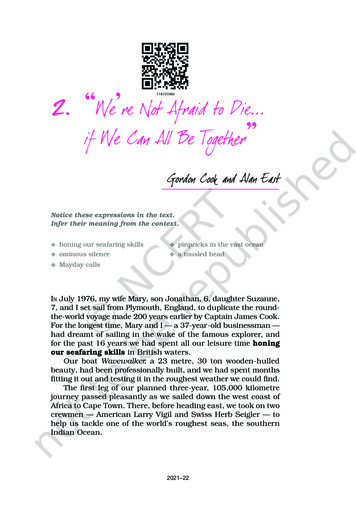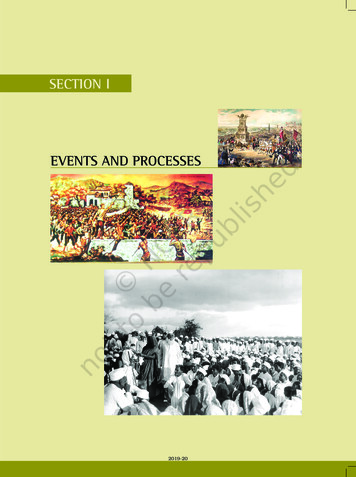
Transcription
SECTION IEVENTS AND PROCESSES2019-20
2019-20
Chapter IT h e NRa t i oinsa l ies m inoEfu r o p eN a t i o n a l i s m i n E u r o p eThe Rise of Nationalism in EuropeFig. 1 — The Dream of Worldwide Democratic and Social Republics – The Pact Between Nations, a print prepared byFrédéric Sorrieu, 1848.In 1848, Frédéric Sorrieu, a French artist, prepared a series of fourprints visualising his dream of a world made up of ‘democraticand social Republics’, as he called them. The first print (Fig. 1) of theseries, shows the peoples of Europe and America – men and womenof all ages and social classes – marching in a long train, and offeringhomage to the statue of Liberty as they pass by it. As you wouldrecall, artists of the time of the French Revolution personified Libertyas a female figure – here you can recognise the torch of Enlightenmentshe bears in one hand and the Charter of the Rights of Man in theother. On the earth in the foreground of the image lie the shatteredremains of the symbols of absolutist institutions. In Sorrieu’sutopian vision, the peoples of the world are grouped as distinctnations, identified through their flags and national costume. Leadingthe procession, way past the statue of Liberty, are the United Statesand Switzerland, which by this time were already nation-states. France,New wordsAbsolutist – Literally, a government orsystem of rule that has no restraints onthe power exercised. In history, the termrefers to a for m of monarchicalgovernment that was centralised,militarised and repressiveUtopian – A vision of a society that is soideal that it is unlikely to actually existActivityIn what way do you think this print (Fig. 1)depicts a utopian vision?32019-20
identifiable by the revolutionary tricolour, has just reached the statue. Source AShe is followed by the peoples of Germany, bearing the black, redErnst Renan, ‘What is a Nation?’and gold flag. Interestingly, at the time when Sorrieu created thisIn a lecture delivered at the University ofimage, the German peoples did not yet exist as a united nation – theSorbonne in 1882, the French philosopher Ernstflag they carry is an expression of liberal hopes in 1848 to unify the Renan (1823-92) outlined his understanding ofnumerous German-speaking principalities into a nation-state under what makes a nation. The lecture wassubsequently published as a famous essay entitleda democratic constitution. Following the German peoples are the‘Qu’est-ce qu’une nation?’ (‘What is a Nation?’).peoples of Austria, the Kingdom of the Two Sicilies, Lombardy, In this essay Renan criticises the notion suggestedPoland, England, Ireland, Hungary and Russia. From the heavens by others that a nation is formed by a commonlanguage, race, religion, or territory:above, Christ, saints and angels gaze upon the scene. They have‘A nation is the culmination of a long past ofbeen used by the artist to symbolise fraternity among the nations of endeavours, sacrifice and devotion. A heroic past,the world.great men, glory, that is the social capital uponThis chapter will deal with many of the issues visualised by Sorrieuin Fig. 1. During the nineteenth century, nationalism emerged as aforce which brought about sweeping changes in the political andmental world of Europe. The end result of these changes was theemergence of the nation-state in place of the multi-national dynasticempires of Europe. The concept and practices of a modern state, inwhich a centralised power exercised sovereign control over a clearlydefined territory, had been developing over a long period of timein Europe. But a nation-state was one in which the majority of itscitizens, and not only its rulers, came to develop a sense of commonidentity and shared history or descent. This commonness did notexist from time immemorial; it was forged through struggles, throughthe actions of leaders and the common people. This chapter willlook at the diverse processes through which nation-states andnationalism came into being in nineteenth-century Europe.which one bases a national idea. To havecommon glories in the past, to have a commonwill in the present, to have performed great deedstogether, to wish to perform still more, theseare the essential conditions of being a people. Anation is therefore a large-scale solidarity Itsexistence is a daily plebiscite A province is itsinhabitants; if anyone has the right to beconsulted, it is the inhabitant. A nation neverhas any real interest in annexing or holding on toa country against its will. The existence of nationsis a good thing, a necessity even. Their existenceis a guarantee of liberty, which would be lost ifthe world had only one law and only one master.’SourceNew wordsIndia and the Contemporary WorldPlebiscite – A direct vote by which all thepeople of a region are asked to accept or rejecta proposalDiscussSummarise the attributes of a nation, as Renanunderstands them. Why, in his view, are nationsimportant?42019-20
1 The French Revolution and the Idea of the NationThe first clear expression of nationalism came withthe French Revolution in 1789. France, as youwould remember, was a full-fledged territorial statein 1789 under the rule of an absolute monarch.The political and constitutional changes that camein the wake of the French Revolution led to thetransfer of sovereignty from the monarchy to abody of French citizens. The revolution proclaimedthat it was the people who would henceforthconstitute the nation and shape its destiny.From the very beginning, the French revolutionariesintroduced various measures and practices thatcould create a sense of collective identity amongstthe French people. The ideas of la patrie (thefatherland) and le citoyen (the citizen) emphasisedthe notion of a united community enjoying equal rights under aconstitution. A new French flag, the tricolour, was chosen to replacethe former royal standard. The Estates General was elected by thebody of active citizens and renamed the National Assembly. Newhymns were composed, oaths taken and martyrs commemorated,all in the name of the nation. A centralised administrative systemwas put in place and it formulated uniform laws for all citizenswithin its territory. Internal customs duties and dues were abolishedand a uniform system of weights and measures was adopted.Regional dialects were discouraged and French, as it was spokenand written in Paris, became the common language of the nation.Fig. 2 — The cover of a German almanacdesigned by the journalist Andreas Rebmann in1798.The image of the French Bastille being stormedby the revolutionary crowd has been placednext to a similar fortress meant to represent thebastion of despotic rule in the German provinceof Kassel. Accompanying the illustration is theslogan: ‘The people must seize their ownfreedom!’ Rebmann lived in the city of Mainzand was a member of a German Jacobin group.N a t i o n a l i s m inEuropeThe revolutionaries further declared that it was the mission and thedestiny of the French nation to liberate the peoples of Europefrom despotism, in other words to help other peoples of Europeto become nations.When the news of the events in France reached the different citiesof Europe, students and other members of educated middle classesbegan setting up Jacobin clubs. Their activities and campaignsprepared the way for the French armies which moved into Holland,Belgium, Switzerland and much of Italy in the 1790s. With theoutbreak of the revolutionary wars, the French armies began tocarry the idea of nationalism abroad.52019-20
ICELAND(DENMARK)ATLANTIC WALESDENMARKRUSSIAN GALICIABAVARIAAUSTRIAN CORSICASARDINIAGEORGIASERBIAOTTOMAN EMPIREKINGDOMOF SYRIAMEDITERRANEAN SEAPALESTINEIndia and the Contemporary WorldEGYPTWithin the wide swathe of territory that came under his control,Napoleon set about introducing many of the reforms that he hadalready introduced in France. Through a return to monarchyNapoleon had, no doubt, destroyed democracy in France, but inthe administrative field he had incorporated revolutionary principlesin order to make the whole system more rational and efficient. TheCivil Code of 1804 – usually known as the Napoleonic Code –did away with all privileges based on birth, established equalitybefore the law and secured the right to property. This Code wasexported to the regions under French control. In the Dutch Republic,in Switzerland, in Italy and Germany, Napoleon simplifiedadministrative divisions, abolished the feudal system and freedpeasants from serfdom and manorial dues. In the towns too, guildrestrictions were removed. Transport and communication systemswere improved. Peasants, artisans, workers and new businessmen62019-20Fig. 3 — Europe after theCongress of Vienna, 1815.
Fig. 4 — The Planting of Tree of Liberty in Zweibrücken, Germany.The subject of this colour print by the German painter Karl Kaspar Fritz is the occupation of the town of Zweibrückenby the French armies. French soldiers, recognisable by their blue, white and red uniforms, have been portrayed asoppressors as they seize a peasant’s cart (left), harass some young women (centre foreground) and force a peasantdown to his knees. The plaque being affixed to the Tree of Liberty carries a German inscription which in translationreads: ‘Take freedom and equality from us, the model of humanity.’ This is a sarcastic reference to the claim of theFrench as being liberators who opposed monarchy in the territories they entered.N a t i o n a l i s m inHowever, in the areas conquered, the reactions of the localpopulations to French rule were mixed. Initially, in many places suchas Holland and Switzerland, as well as in certain cities like Brussels,Mainz, Milan and Warsaw, the French armies were welcomed asharbingers of liberty. But the initial enthusiasm soon turned to hostility,as it became clear that the new administrative arrangements did notgo hand in hand with political freedom. Increased taxation,censorship, forced conscription into the French armies required toconquer the rest of Europe, all seemed to outweigh the advantagesof the administrative changes.Europeenjoyed a new-found freedom. Businessmen and small-scaleproducers of goods, in particular, began to realise that uniformlaws, standardised weights and measures, and a common nationalcurrency would facilitate the movement and exchange of goodsand capital from one region to another.Fig. 5 — The courier of Rhineland loses all thathe has on his way home from Leipzig.Napoleon here is represented as a postman onhis way back to France after he lost the battle ofLeipzig in 1813. Each letter dropping out of hisbag bears the names of the territories he lost.72019-20
2 The Making of Nationalism in EuropeIf you look at the map of mid-eighteenth-century Europe you willfind that there were no ‘nation-states’ as we know them today.What we know today as Germany, Italy and Switzerland weredivided into kingdoms, duchies and cantons whose rulers had theirautonomous territories. Eastern and Central Europe were underautocratic monarchies within the territories of which lived diversepeoples. They did not see themselves as sharing a collective identityor a common culture. Often, they even spoke different languagesand belonged to different ethnic groups. The Habsburg Empirethat ruled over Austria-Hungary, for example, was a patchwork ofmany different regions and peoples. It included the Alpine regions– the Tyrol, Austria and the Sudetenland – as well as Bohemia,where the aristocracy was predominantly German-speaking. It alsoincluded the Italian-speaking provinces of Lombardy and Venetia.In Hungary, half of the population spoke Magyar while the otherhalf spoke a variety of dialects. In Galicia, the aristocracy spokePolish. Besides these three dominant groups, there also lived withinthe boundaries of the empire, a mass of subject peasant peoples –Bohemians and Slovaks to the north, Slovenes in Carniola, Croatsto the south, and Roumans to the east in Transylvania. Suchdifferences did not easily promote a sense of political unity. Theonly tie binding these diverse groups together was a commonallegiance to the emperor.India and the Contemporary WorldHow did nationalism and the idea of the nation-state emerge?2.1 The Aristocracy and the New Middle ClassSocially and politically, a landed aristocracy was the dominant classon the continent. The members of this class were united by acommon way of life that cut across regional divisions. They ownedestates in the countryside and also town-houses. They spoke Frenchfor purposes of diplomacy and in high society. Their families wereoften connected by ties of marriage. This powerful aristocracy was,however, numerically a small group. The majority of the populationwas made up of the peasantry. To the west, the bulk of the landwas farmed by tenants and small owners, while in Eastern andCentral Europe the pattern of landholding was characterised byvast estates which were cultivated by serfs.82019-20Some important dates1797Napoleon invades Italy; Napoleonic warsbegin.1814-1815Fall of Napoleon; the Vienna PeaceSettlement.1821Greek struggle for independence begins.1848Revolutions in Europe; artisans, industrialworkers and peasants revolt againsteconomic hardships; middle classesdemand constitutions and representativegovernments; Italians, Germans, Magyars,Poles, Czechs, etc. demand nation-states.1859-1870Unification of Italy.1866-1871Unification of Germany.1905Slav nationalism gathers force in theHabsburg and Ottoman Empires.
In Western and parts of Central Europe the growth of industrialproduction and trade meant the growth of towns and the emergenceof commercial classes whose existence was based on productionfor the market. Industrialisation began in England in the secondhalf of the eighteenth century, but in France and parts of the Germanstates it occurred only during the nineteenth century. In its wake,new social groups came into being: a working-class population, andmiddle classes made up of industrialists, businessmen, professionals.In Central and Eastern Europe these groups were smaller in numbertill late nineteenth century. It was among the educated, liberal middleclasses that ideas of national unity following the abolition ofaristocratic privileges gained popularity.2.2 What did Liberal Nationalism Stand for?Ideas of national unity in early-nineteenth-century Europe were closelyallied to the ideology of liberalism. The term ‘liberalism’ derivesfrom the Latin root liber, meaning free. For the new middle classesliberalism stood for freedom for the individual and equality of allbefore the law. Politically, it emphasised the concept of governmentby consent. Since the French Revolution, liberalism had stood forthe end of autocracy and clerical privileges, a constitution andrepresentative government through parliament. Nineteenth-centuryliberals also stressed the inviolability of private property.New wordsEuropeSuffrage – The right to voteN a t i o n a l i s m inYet, equality before the law did not necessarily stand for universalsuffrage. You will recall that in revolutionary France, which markedthe first political experiment in liberal democracy, the right to voteand to get elected was granted exclusively to property-owning men.Men without property and all women were excluded from politicalrights. Only for a brief period under the Jacobins did all adult malesenjoy suffrage. However, the Napoleonic Code went back to limitedsuffrage and reduced women to the status of a minor, subject tothe authority of fathers and husbands. Throughout the nineteenthand early twentieth centuries women and non-propertied menorganised opposition movements demanding equal political rights.In the economic sphere, liberalism stood for the freedom of marketsand the abolition of state-imposed restrictions on the movementof goods and capital. During the nineteenth century this was a strongdemand of the emerging middle classes. Let us take the example ofthe German-speaking regions in the first half of the nineteenthcentury. Napoleon’s administrative measures had created out of92019-20
countless small principalities a confederation of 39 states. Each of Source Bthese possessed its own currency, and weights and measures. AEconomists began to think in terms of the nationalmerchant travelling in 1833 from Hamburg to Nuremberg to selleconomy. They talked of how the nation couldhis goods would have had to pass through 11 customs barriers anddevelop and what economic measures could helpforge this nation together.pay a customs duty of about 5 per cent at each one of them. DutiesFriedrich List, Professor of Economics at thewere often levied according to the weight or measurement of theUniversity of Tübingen in Germany, wrote in 1834:goods. As each region had its own system of weights and measures,‘The aim of the zollverein is to bind the Germansthis involved time-consuming calculation. The measure of cloth,economically into a nation. It will strengthen thefor example, was the elle which in each region stood for a differentnation materially as much by protecting itsinterests externally as by stimulating its internallength. An elle of textile material bought in Frankfurt would get youproductivity. It ought to awaken and raise54.7 cm of cloth, in Mainz 55.1 cm, in Nuremberg 65.6 cm, innational sentiment through a fusion of individualFreiburg 53.5 cm.and provincial interests. The German people haveIndia and the Contemporary WorldSuch conditions were viewed as obstacles to economic exchangeand growth by the new commercial classes, who argued for thecreation of a unified economic territory allowing the unhinderedmovement of goods, people and capital. In 1834, a customs unionor zollverein was formed at the initiative of Prussia and joined bymost of the German states. The union abolished tariff barriers andreduced the number of currencies from over thirty to two. Thecreation of a network of railways further stimulated mobility,harnessing economic interests to national unification. A wave ofeconomic nationalism strengthened the wider nationalist sentimentsgrowing at the time.realised that a free economic system is the onlymeans to engender national feeling.’SourceDiscussDescribe the political ends that List hopes toachieve through economic measures.2.3 A New Conservatism after 1815New wordsFollowing the defeat of Napoleon in 1815, European governmentswere driven by a spirit of conservatism. Conservatives believedthat established, traditional institutions of state and society – like themonarchy, the Church, social hierarchies, property and the family –should be preserved. Most conservatives, however, did not proposea return to the society of pre-revolutionary days. Rather, they realised,from the changes initiated by Napoleon, that modernisation couldin fact strengthen traditional institutions like the monarchy. It couldmake state power more effective and strong. A modern army, anefficient bureaucracy, a dynamic economy, the abolition of feudalismand serfdom could strengthen the autocratic monarchies of Europe.Conservatism – A political philosophy thatstressed the importance of tradition, establishedinstitutions and customs, and preferred gradualdevelopment to quick changeIn 1815, representatives of the European powers – Britain, Russia,Prussia and Austria – who had collectively defeated Napoleon, metat Vienna to draw up a settlement for Europe. The Congress washosted by the Austrian Chancellor Duke Metternich. The delegates102019-20
drew up the Treaty of Vienna of 1815 with the object of undoingmost of the changes that had come about in Europe during theNapoleonic wars. The Bourbon dynasty, which had been deposedduring the French Revolution, was restored to power, and Francelost the territories it had annexed under Napoleon. A series of stateswere set up on the boundaries of France to prevent French expansionin future. Thus the kingdom of the Netherlands, which includedBelgium, was set up in the north and Genoa was added to Piedmontin the south. Prussia was given important new territories on its westernfrontiers, while Austria was given control of northern Italy. But theGerman confederation of 39 states that had been set up by Napoleonwas left untouched. In the east, Russia was given part of Polandwhile Prussia was given a portion of Saxony. The main intentionwas to restore the monarchies that had been overthrown byNapoleon, and create a new conservative order in Europe.Plot on a map of Europe the changes drawnup by the Vienna Congress.DiscussWhat is the caricaturist trying to depict?N a t i o n a l i s m inEuropeConservative regimes set up in 1815 were autocratic. They did nottolerate criticism and dissent, and sought to curb activities thatquestioned the legitimacy of autocratic governments. Most of themimposed censorship laws to control what was said in newspapers,books, plays and songs and reflected the ideas of liberty and freedomActivityFig. 6 — The Club of Thinkers, anonymous caricature dating to c. 1820.The plaque on the left bears the inscription: ‘The most important question of today’s meeting: Howlong will thinking be allowed to us?’The board on the right lists the rules of the Club which include the following:‘1. Silence is the first commandment of this learned society.2. To avoid the eventuality whereby a member of this club may succumb to the temptation ofspeech, muzzles will be distributed to members upon entering.’112019-20
associated with the French Revolution. The memory of the FrenchRevolution nonetheless continued to inspire liberals. One of the majorissues taken up by the liberal-nationalists, who criticised the newconservative order, was freedom of the press.2.4 The RevolutionariesIndia and the Contemporary WorldDuring the years following 1815, the fear of repression drove manyliberal-nationalists underground. Secret societies sprang up in manyEuropean states to train revolutionaries and spread their ideas. Tobe revolutionary at this time meant a commitment to opposemonarchical forms that had been established after the ViennaCongress, and to fight for liberty and freedom. Most of theserevolutionaries also saw the creation of nation-states as a necessarypart of this struggle for freedom.One such individual was the Italian revolutionary Giuseppe Mazzini.Born in Genoa in 1807, he became a member of the secret societyof the Carbonari. As a young man of 24, he was sent into exile in1831 for attempting a revolution in Liguria. He subsequently foundedtwo more underground societies, first, Young Italy in Marseilles,and then, Young Europe in Berne, whose members were like-mindedyoung men from Poland, France, Italy and the German states.Mazzini believed that God had intended nations to be the naturalunits of mankind. So Italy could not continue to be a patchwork ofsmall states and kingdoms. It had to be forged into a single unifiedrepublic within a wider alliance of nations. This unification alonecould be the basis of Italian liberty. Following his model, secretsocieties were set up in Germany, France, Switzerland and Poland.Mazzini’s relentless opposition to monarchy and his vision ofdemocratic republics frightened the conservatives. Metternichdescribed him as ‘the most dangerous enemy of our social order’.122019-20Fig. 7 — Giuseppe Mazzini and the founding ofYoung Europe in Berne 1833.Print by Giacomo Mantegazza.
3 The Age of Revolutions: 1830-1848As conservative regimes tried to consolidate their power, liberalismand nationalism came to be increasingly associated with revolutionin many regions of Europe such as the Italian and German states,the provinces of the Ottoman Empire, Ireland and Poland. Theserevolutions were led by the liberal-nationalists belonging to theeducated middle-class elite, among whom were professors, schoolteachers, clerks and members of the commercial middle classes.The first upheaval took place in France in July 1830. The Bourbonkings who had been restored to power during the conservativereaction after 1815, were now overthrown by liberal revolutionarieswho installed a constitutional monarchy with Louis Philippe at itshead. ‘When France sneezes,’ Metternich once remarked, ‘the rest ofEurope catches cold.’ The July Revolution sparked an uprising inBrussels which led to Belgium breaking away from the UnitedKingdom of the Netherlands.EuropeAn event that mobilised nationalist feelings among the educated eliteacross Europe was the Greek war of independence. Greece hadbeen part of the Ottoman Empire since the fifteenth century. Thegrowth of revolutionary nationalism in Europe sparked off a strugglefor independence amongst the Greeks which began in 1821.Nationalists in Greece got support from other Greeks living in exileand also from many West Europeans who had sympathies for ancientGreek culture. Poets and artists lauded Greece as the cradle ofEuropean civilisation and mobilised public opinion to support itsstruggle against a Muslim empire. The English poet Lord Byronorganised funds and later went to fight in the war, where he died offever in 1824. Finally, the Treaty of Constantinople of 1832recognised Greece as an independent nation.N a t i o n a l i s m in3.1 The Romantic Imagination and National FeelingThe development of nationalism did not come about only throughwars and territorial expansion. Culture played an important role increating the idea of the nation: art and poetry, stories and musichelped express and shape nationalist feelings.Let us look at Romanticism, a cultural movement which sought todevelop a particular form of nationalist sentiment. Romantic artistsand poets generally criticised the glorification of reason and science132019-20
India and the Contemporary WorldFig. 8 — The Massacre at Chios, Eugene Delacroix, 1824.The French painter Delacroix was one of the most important French Romanticpainters. This huge painting (4.19m x 3.54m) depicts an incident in which20,000 Greeks were said to have been killed by Turks on the island of Chios. Bydramatising the incident, focusing on the suffering of women and children, andusing vivid colours, Delacroix sought to appeal to the emotions of the spectators,and create sympathy for the Greeks.and focused instead on emotions, intuition and mystical feelings.Their effort was to create a sense of a shared collective heritage, acommon cultural past, as the basis of a nation.Other Romantics such as the German philosopher Johann GottfriedHerder (1744-1803) claimed that true German culture was to bediscovered among the common people – das volk. It was throughfolk songs, folk poetry and folk dances that the true spirit of thenation (volksgeist) was popularised. So collecting and recording theseforms of folk culture was essential to the project of nation-building.142019-20
The emphasis on vernacular language and the collection of localfolklore was not just to recover an ancient national spirit, but also tocarry the modern nationalist message to large audiences who weremostly illiterate. This was especially so in the case of Poland, whichhad been partitioned at the end of the eighteenth century by theGreat Powers – Russia, Prussia and Austria. Even though Poland nolonger existed as an independent territory, national feelings were keptalive through music and language. Karol Kurpinski, for example,celebrated the national struggle through his operas and music, turningfolk dances like the polonaise and mazurka into nationalist symbols.Language too played an important role in developing nationalistsentiments. After Russian occupation, the Polish language was forcedout of schools and the Russian language was imposed everywhere.In 1831, an armed rebellion against Russian rule took place whichwas ultimately crushed. Following this, many members of the clergyin Poland began to use language as a weapon of national resistance.Polish was used for Church gatherings and all religious instruction.As a result, a large number of priests and bishops were put in jail orsent to Siberia by the Russian authorities as punishment for theirrefusal to preach in Russian. The use of Polish came to be seen as asymbol of the struggle against Russian dominance.Box 1The Grimm Brothers: Folktales andNation-buildingGrimms’ Fairy Tales is a familiar name. The brothersJacob and Wilhelm Grimm were born in theGerman city of Hanau in 1785 and 1786respectively. While both of them studied law,they soon developed an interest in collecting oldfolktales. They spent six years travelling fromvillage to village, talking to people and writingdown fairy tales, which were handed downthrough the generations. These were popularboth among children and adults. In 1812, theypublished their first collection of tales.Subsequently, both the brothers became activein liberal politics, especially the movementfor freedom of the press. In the meantime theyalso published a 33-volume dictionary of theGerman language.The Grimm brothers also saw French dominationas a threat to German culture, and believed thatthe folktales they had collected were expressionsof a pure and authentic German spirit. Theyconsidered their projects of collecting folktalesand developing the German language as part ofthe wider effort to oppose French dominationand create a German national identity.3.2 Hunger, Hardship and Popular RevoltDiscussDiscuss the importance of language andpopular traditions in the creation of nationalEuropeidentity.N a t i o n a l i s m inThe 1830s were years of great economic hardship in Europe. Thefirst half of the nineteenth century saw an enormous increase inpopulation all over Europe. In most countries there were moreseekers of jobs than employment. Population from rural areasmigrated to the cities to live in overcrowded slums. Small producersin
the world. This chapter will deal with many of the issues visualised by Sorrieu in Fig . 1. During the nineteenth centur y, na tionalism emer ged as a force which brought about sweeping changes in the political and mental world of Europe. The end result of these changes was the emergence of
